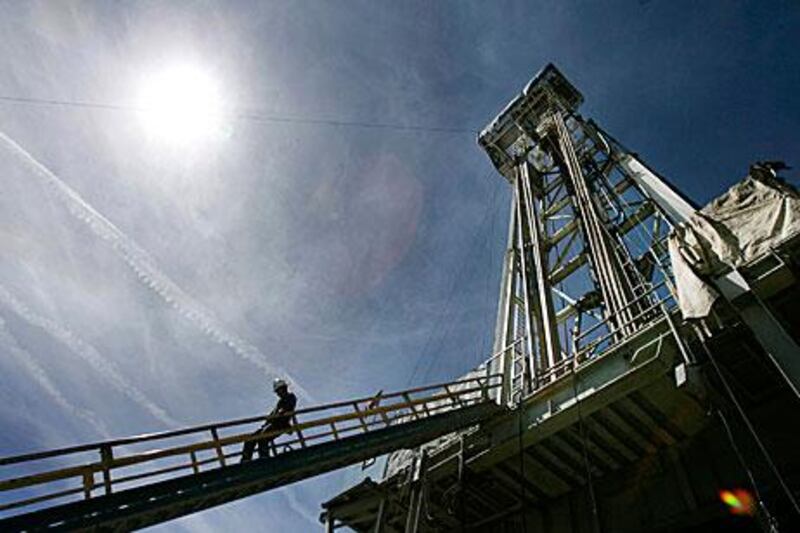Geothermal energy developers plan to pump 91 million litres of water into the side of a dormant volcano this summer to demonstrate new technology they hope will give a boost to green energy.
They hope the water comes back to the surface fast enough and hot enough to create cheap, clean electricity that is not dependent on sunny skies or stiff breezes.
They also want to see if the water injected into the volcano in the western US state of Oregon will resurface without shaking the earth and rattling the nerves of nearby residents.
Renewable energy has been held back by cheap natural gas, weak demand for power and waning political concern over global warming. Efforts to use the Earth's heat to generate power, known as geothermal energy, have been further hampered by technical problems and worries that tapping it can cause earthquakes.
Even so, the US government, Google and other investors are interested enough to bet US$43 million (Dh158m) on the Oregon project. They are helping AltaRock Energy of Washington state and Davenport Newberry Holdings of Connecticut to demonstrate whether the next level in geothermal power development can work on the flanks of Newberry Volcano.
"We know the heat is there," said Susan Petty, president of AltaRock. "The big issue is can we circulate enough water through the system to make it economic."
The heat in the Earth's crust has been used to generate power for more than a century. Engineers gather hot water or steam that bubbles near the surface and use it to spin a turbine that creates electricity. Most of those areas have been exploited. The new frontier is places with hot rocks, but no cracks in the rocks or water to deliver the steam. To tap that heat - and grow geothermal energy from a tiny niche into an important source of green energy - engineers are working on a new technology called Enhanced Geothermal Systems (EGS).
"To build geothermal in a big way beyond where it is now requires new technology, and that is where EGS comes in," said Steve Hickman, a research geophysicist with the US Geological Survey in California.
Wells are drilled deep into the rock and water is pumped in, creating tiny fractures in the rock, a process known as hydroshearing.
Cold water is pumped down production wells into the reservoir, and the steam is drawn out.
Hydroshearing is similar to the process known as hydraulic fracturing, used to free natural gas from shale formations. But fracking uses chemical-laden fluids, and creates huge fractures. Pumping fracking wastewater deep underground for disposal probably led to recent earthquakes in Arkansas and Ohio.
Fears persist that cracking rock deep underground through hydroshearing can also lead to damaging quakes. EGS has other problems. It is hard to create a reservoir big enough to run a commercial power plant.
Progress has been slow. Two small plants are online in France and Germany. A third in downtown Basel, Switzerland, was shut down over earthquake complaints. A project in Australia has had drilling problems.
A new international protocol is coming out at the end of this month that urges EGS developers to keep projects out of urban areas, the so-called "sanity test," said Ernie Majer, a seismologist with the Lawrence Berkeley National Laboratory. It also urges developers to be upfront with local residents so they know exactly what is going on.
AltaRock hopes to demonstrate a new technology for creating bigger reservoirs that is based on the plastic polymers used to make biodegradable cups.
It worked in existing geothermal fields. Newberry will show if it works in a brand new EGS field, and in a different kind of geology, volcanic rock, said Colin Williams, a USGS geophysicist.
The US Department of Energy has given the project $21.5 million in stimulus funds. That has been matched by private investors, among them Google with $6.3 million.
Mr Majer said the danger of a major quake at Newbery is very low. The area is a kind of seismic dead zone, with no significant faults. It is far enough from population centres to make property damage unlikely. And the layers of volcanic ash built up over millennia dampen any shaking.
The US Department of Energy will be keeping a close eye on the project, and any significant quakes would shut it down at least temporarily, he said. The agency is also monitoring EGS projects at existing geothermal fields in California, Nevada and Idaho.
"That's the $64,000 question," Mr Majer said. "What's the biggest earthquake we can have from induced seismicity that the public can worry about."
Geologists believe Newberry Volcano was once one of the tallest peaks in the Cascades, reaching an elevation of 10,000 feet and a diameter of 20 miles. It blew its top before the last Ice Age, leaving a caldera studded with towering lava flows, two lakes, and 400 cinder cones, some 400 feet tall.






